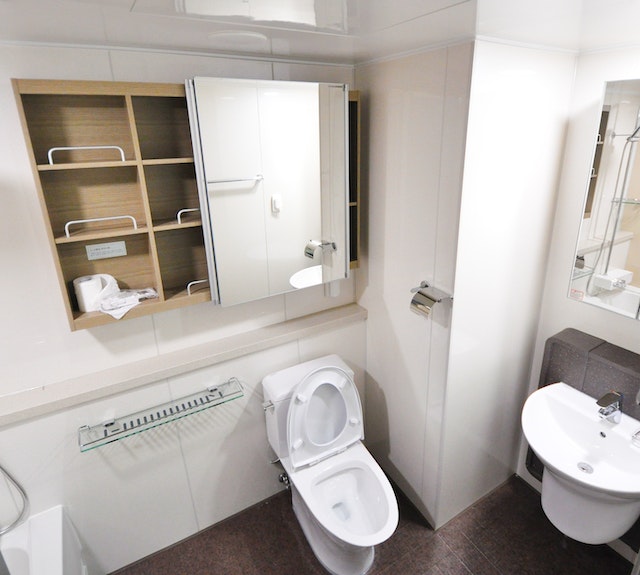
When did people start using flushing toilets? It was invented in 1596, but didn’t start to become common until the 1850s.
People have used toilets for thousands of years, but they were usually just a pit or a hole. The first toilet to use a drainage system and running water was found by archaeologists in northwest India from 4,000 years ago. In 1700 BC, the Greeks had a system that used earthenware pans and a flushing water supply. This was in Knossos, which is said to be the oldest city in Europe. The Romans used communal toilets that used running water to wash waste away. The Romans were the first people to create a sewer system as well. Possible flushing toilets have been discovered in China, from about 500 BC, which suggests some palaces may have had a flushing toilet system.
In the Middle Ages, some castles had a room that had a toilet opening that was over the moat. These rooms were called garderobes, which could come from the fact that people used to store clothes in these rooms because the ammonia from the urine would discourage fleas and parasites, thereby guarding the robes. Most houses just used a bucket or a pot and most waste was thrown into rivers, moats, or left on the ground. The River Thames in London was notoriously for its smell and it was said that sometimes you could walk on its surface because it was so thick.
The first flushing toilet that used the system that we still recognize today was invented by Sir John Harrington in 1596. He built it in his house and then write about it in a 110 page book called A New Discourse of a Stale Subject, Called the Metamorphosis of Ajax. He appears to have written it as a satire and used the idea of “flushing a toilet” as “flushing away the faults of the times and the monarchy”. He was the godson of Elizabeth I, but he fell out of favor with the court. He called his toilet the Ajax, hence the name of his book. Jakes was slang for the toilet at the time. His toilet had a cistern raised up above the toilet bowl. When it was flushed, water ran out of the cistern and was forced down into the bowl, emptying it. He built a toilet for his godmother, Queen Elizabeth, and some of his friends, but it didn’t take off. There is some argument over whether the American expression john for toilet has anything to do with John Harrington. It is probably more likely that it evolved from jakes.
Alexander Cumming invented the S-trap in 1775, which probably did more to make flush toilets the way to go than anyone. The S-trap uses water from the toilet bowl to create a seal in the pipe and to stop foul smells coming back up the pipe from the sewer. With this invention, and for possibly the first time in history, toilets didn’t smell anymore.
There were more small inventions that made the flushing toilet what it is today, but most people couldn’t afford one. It wasn’t until the 1850s that flush toilets took off. Three things happened to push people to switch to flush toilets. The first thing was the large-scale urbanization that happened with the industrial revolution. More people were moving in to the city for jobs and there was so much waste that it was no longer practical to just throw it out of the window or into a river. The second thing was the industrial revolution itself. It became possible to mass produce the parts that were needed for the flush toilet, which brought their price down. However, the third reason was probably the most likely.
Because of all the sewage that was thrown into the river Thames and other water sources in London, many of the city’s water supplies became infected with cholera. There were several cholera outbreaks in the city, between 1848 killing and 1854. It was only in 1854 that John Snow, an English physician, worked out that the disease was spreading from contaminated water. He published his findings and the government realized that they needed to do something. Resources were pumped into expanding the sewerage system, giving people access to clean water, and giving people access to flushing, hygienic toilets that were attached to the sewerage system. Many people still had outside toilets, but they had flushing toilets. This was the point where the flushing toilet became common. And this is what I learned today.
Sources
https://www.ncbi.nlm.nih.gov/pmc/articles/PMC7150208/
https://www.history.com/news/who-invented-the-flush-toilet
https://www.smithsonianmag.com/history/turrets-toilets-partial-history-throne-room-180951788/
https://en.wikipedia.org/wiki/Knossos
https://www.baus.org.uk/museum/164/a_brief_history_of_the_flush_toilet
https://english.stackexchange.com/questions/41021/why-is-a-bathroom-sometimes-called-a-john
https://en.wikipedia.org/wiki/John_Harington_(writer)
https://www.exclassics.com/ajax/ajax.pdf
https://en.wikipedia.org/wiki/Flush_toilet
